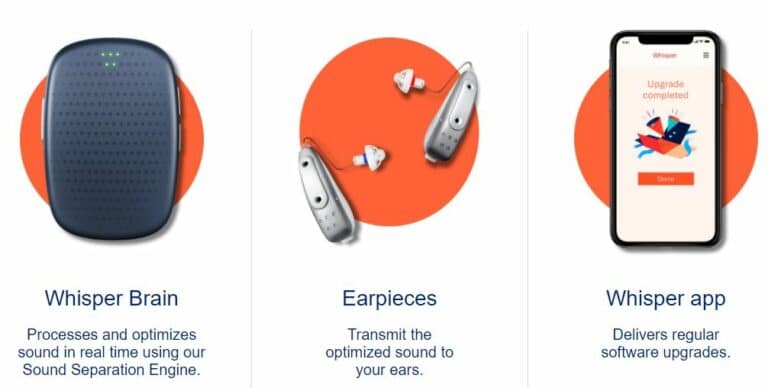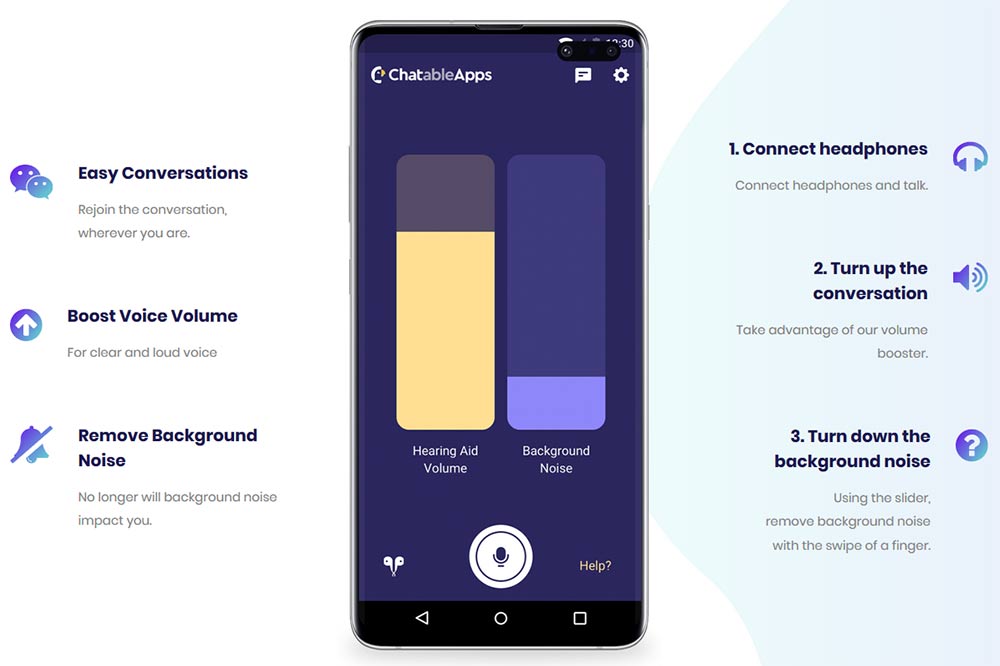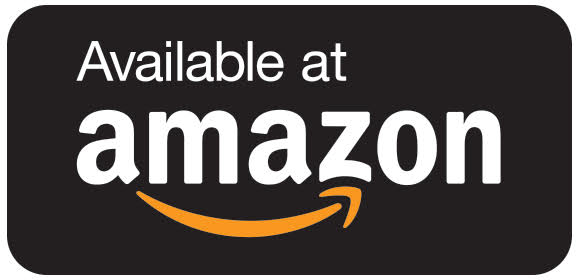In the first article, we explored some of the recent innovation and changes in the hearing aid world that may affect the future of hearing aids. In this article, I want to look at some of the players offering non-traditional solutions for hearing correction which is more often than not called augmented audio. This space has been as fascinating as the traditional hearing aid market in the last few years and some pretty heavyweight consumer electronics companies are active in it. Just a few years ago, who would have thought that Apple would offer what amounts to a hearing aid feature in their earbuds? Or that the market for personalised headphones would explode? Who considered that artificial intelligence (AI) or machine learning could be a growing technology in the effort to offer better solutions for hearing loss? Could anyone see the time when earbuds masqueraded as hearing aids and hearing aids pretended to be earbuds? As my esteemed colleague, Steve says, it's all going off Geoff! Let's talk about augmented audio for the masses!

AI-driven hearing
The image above is taken from the site of Whisper Hearing, we covered them towards the end of last year. They are a very interesting new entrant into the hearing correction world. They introduced AI-powered hearing aids that self-tune and update over time. These aren't hearing aids in the traditional sense.
The Whisper Hearing System is just that, a system that compromises earbuds that look like Receiver In Canal Hearing Aids, a small pocket device which they say is the brain of the system and a mobile app that allows users to control the system and apply upgrades.
They are still ploughing away in the states and just recently pushed out their first update to their system. The model is different as well, it is a subscription model and they promise to continually update the system to make them better. I include them here because they are an overt case of change driven by AI.
Not All Device Driven
The innovation has not been all device-driven though, by that I mean something you wear on your ear. Some of the most interesting innovation I have seen is in fact system and app-based. Take SonicCloud for instance. Their system is app-based but works to change audio output across a range of your devices.
Their site says "Turn your phone or laptop into a powerful hearing solution in three easy steps". SonicCloud offers a self-tuned speech intelligibility system that will give you customised audio. The beauty of it? In theory, it could be embedded on any audio device. Your TV, your Hi-Fi, certainly your phone and computer. As you will see in a couple of paragraphs, that revolution has just begun.
Mimi is another player with a similar idea, again their system is app-based and they say it can be integrated with pretty much any audio solution to drive a more personalised (read corrective audio) sound experience. Philips TV line-up of 2021 will have Mimi sound personalisation integrated.

Chatable apps is another player I spoke about last year, they offer is a Smartphone-based app that promises to deliver a better understanding of speech in noise to anyone that wants it. The app sits at the cutting edge of Neuroscience and Artificial Intelligence and approaches the hearing in noise problem in a way no one else has. The app works well and feedback on it from many users is that it is outstanding.
Disguised hearing solutions

As I said in the intro, there are now several consumer electronics devices on offer that do hearing aid things. NuHeara with their earbuds, Alango technologies with theirs, Apple with its augmented audio transparency mode in Airpods Pro. One of the drawbacks of these offerings is battery life and to a certain extent comfort. The devices offer self-programmed hearing loss correction but you could only call them situational solutions. They aren't an all-day everyday solution. In fairness, they don't pretend to be and they are focused on delivering help to those people who feel they have situational needs.
Speaking of situational needs, there are many consumer electronics companies looking to help you out with just that. Not satisfied with your music experience any longer? Well, why not try out Nuraphone or Anker headphones? Hell, why not try out any of the myriads of offerings from an exploding market of them?
Having trouble catching the dialogue on the TV? Funnily enough, Sennheiser (recently bought by Sonova) has several solutions for you, so do half a dozen soundbar manufacturers, even Sony is getting in on the act with a new personal wearable speaker for Sony TVs designed in tandem with SonicCloud, the guys I mentioned earlier.
As I said earlier, Philips TVs will soon have Mimi systems integrated and many of the TV brands are looking at augmented audio for the correction of hearing loss more deeply right now. It makes sense for them to offer an integrated solution to increase the enjoyment of their products. I don't want to labour the point here, but solutions for situational hearing problems are exploding right now and I don't expect that to slow down any time soon.
Voice-First
Voice first is a concept that has been around for a while, in essence, it is the idea that your voice will be the interface for technology moving forward. It makes sense and we have seen moves towards this concept with digital assistants which grew out of the voice typing systems. The concept is simple, why type when you can speak?
While it seems like a strange technology to include here, it isn't because of the way it is shaping up. One of the best places to put a voice-first device is at ear level, it serves two purposes, it is near your mouth and it can give you audio feedback.
Many of the hearing aid manufacturers and consumer electronics companies recognise this and include a way to integrate it into their devices, think Tap Control from Phonak and similar systems from Starkey and NuHeara. Voice first will grow exponentially because it makes life easier for consumers.
It will also help to grow the concept of ear level integrated communication devices over time. You can expect it to help to normalise the idea of ear-level devices as an everyday consumer device. Once people experience using it, they won't want to go back to before.
Health at the ear level
Another concept that will only grow is the concept of so-called healthables, Starkey has burned a bright path here. With the introduction of the Livio AI a couple of years ago they made it clear that they felt their future was tied to offering hearing aids that offered many more health-related features. Their device is a kind of holistic solution offering hearing loss correction and health monitoring that combined will help to keep their users fitter and well for longer.
The ear is a fantastic place for the monitoring of health, it offers the opportunity to take bio readings for many needs including an EEG believe it or not. The exploration of the ear and the abilities for bio measurements may also help us in the future with so-called brain steered hearing aids. The idea is that the hearing aids read your brains intent in a sound situation and deliver the augmented audio you wish.
It isn't quite as far fetched as it sounds, but we are many years away from commercial applications. In the first article, I briefly mentioned brain-machine interfaces. Brain steered hearing aids is one type of brain-machine interface. We really are moving towards a cyborg future at this rate, it might seem alien to us, but I bet your great Grandchildren will probably witness it.
In the last article, I raised the question what if augmented situational devices lower the demand for hearing aids? As you can see from everything I have spoken about here, there are more and more situational solutions becoming available. One of the repeated things I hear in the clinic is, I have to turn the TV right up but I still don't hear it clearly! It is often a point of real frustration and the source of family arguments.
Another thing I hear often is that I have no problems except for noisy situations, then I struggle. Or, I find talking on the phone a little difficult because things aren't quite clear enough. If there are cheap, easy solutions for those problems, will that dilute the adoption of hearing aids, no matter what way they are purchased? I think it might, however, I also think that it will encourage the adoption of a more permanent solution in the future as the user recognises the problems creeping into more of their life.
I am sorry, I said I would round-up with my thoughts on the future of provision, but as I sit here I think there is way too much to discuss and explore. I want to be able to discuss it and explore why I believe it to be so and what technologies may make it happen. So, I am going to leave you now and come back with a third article.
I will say this, I don't think the traditional provision model will remain as it is today for many more years. The model and what it offers will change. I also believe that traditional hearing aid manufacturers will eventually become involved in the OTC market, all of them, with no exceptions. I also believe that the innovation happening right now, the introduction of OTC devices and situational solutions will increase the demand for better hearing correction solutions, will they still be called hearing aids?
Maybe, but I think everyday correction of hearing loss will probably be just one facet of what they do. Like us on Facebook by clicking the button below to keep up with our latest utterances. Alternatively, if you don't like Facebook, sign up for the newsletter below. It is important to remember, a hearing aid isn't properly fitted unless they do Real Ear Measurement.










